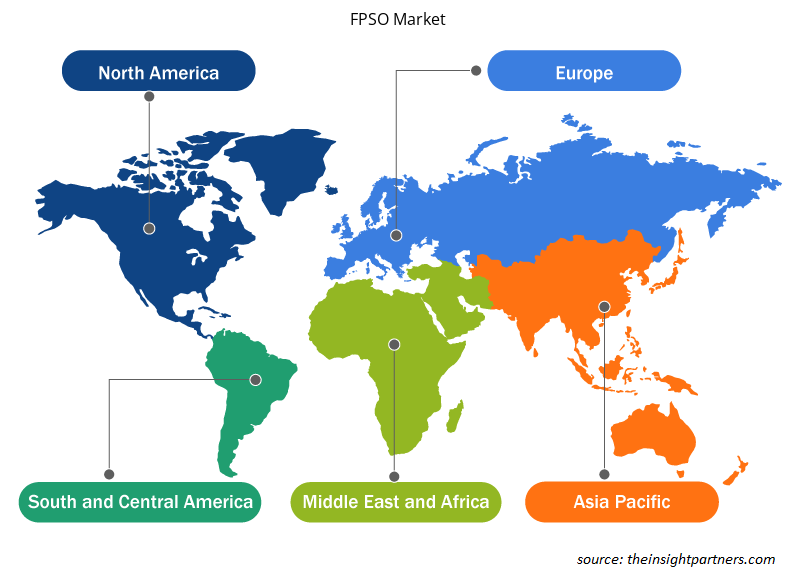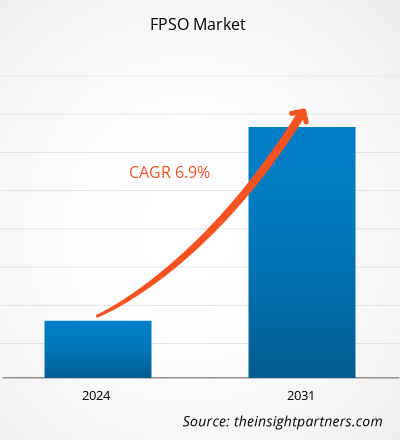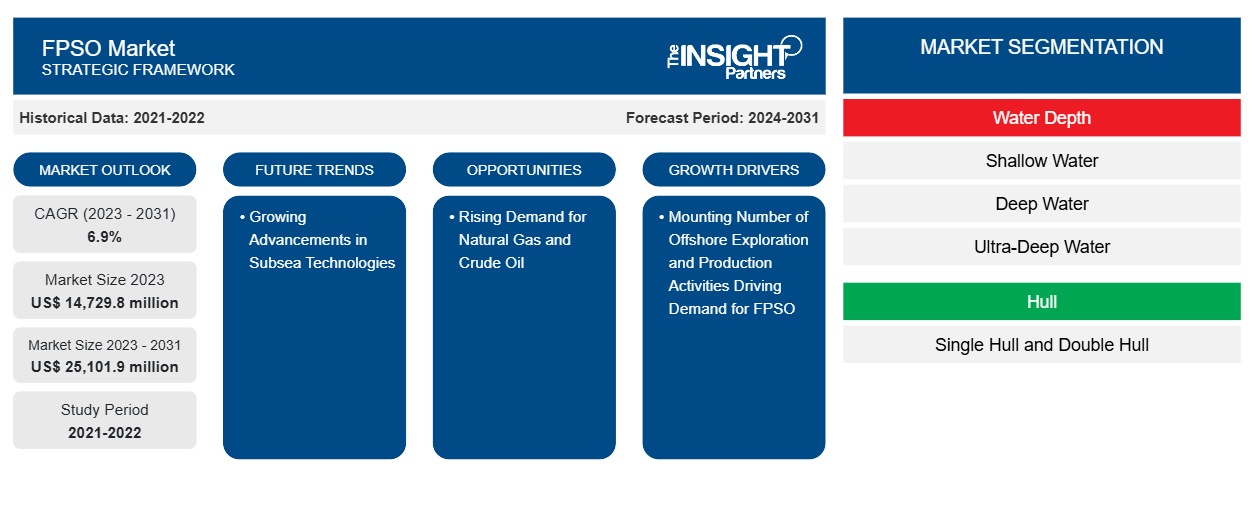Der FPSO-Markt soll von 14.729,8 Millionen US-Dollar im Jahr 2023 auf 25.101,9 Millionen US-Dollar im Jahr 2031 anwachsen. Der Markt soll zwischen 2023 und 2031 eine durchschnittliche jährliche Wachstumsrate (CAGR) von 6,9 % verzeichnen. Die zunehmende Entwicklung des Öl- und Gassektors sowie die zunehmenden Öl- und Gasexplorationsaktivitäten sind weitere Trends für den FPSO-Markt.
FPSO-Marktanalyse
Die zunehmende Ausweitung von Öl- und Gasprojekten ist der Hauptfaktor, der die Nachfrage nach FPSO ankurbelt. Die Nachfrage nach FPSO, insbesondere im Offshore-Bereich, gepaart mit einem mäßig stabilen Ölpreis und einem Anstieg der Offshore-Explorations- und Ölproduktionsaktivitäten dürfte in den nächsten fünf Jahren zu einem starken Wachstum der weltweiten Nachfrage nach FPSO-Schiffen führen. Einige der wichtigsten FPSO-Unternehmen wie Total Energies, Petrobras, CNOOC Ltd, Equinor ASA und Exxon Mobil konzentrieren sich darauf, die Entwicklung des FPSO-Marktes voranzutreiben.
FPSO-Marktübersicht
Die Öl- und Gasexplorationsunternehmen wie Equinor ASA konzentrieren sich auf die Öl- und Gasexploration in tiefen und ultratiefen Gewässern. So hat Shell beispielsweise im Jahr 2022 ein Projekt zur Ölförderung im PowerNap-Feld gestartet. Darüber hinaus implementieren Öl- und Gasunternehmen aufgrund der Entwicklungen in der Offshore-Technologie neuartige Technologien wie teilbare Türme, zylindrische Rumpfkonstruktionen und Doppelrumpfkonstruktionen. Darüber hinaus erhöhen die technologischen Entwicklungen bei FPSO gegenüber anderen Produktionssystemen, wie die Digitalisierung von FPSO und die Durchdringung der Öl- und Gasindustrie mit Automatisierung und vielem mehr, den Fokus der Marktunternehmen auf F&E-Aktivitäten und die Entwicklung neuer Produkte, was in den kommenden Jahren Trends für das Wachstum des FPSO-Marktes generieren wird.
Passen Sie diesen Bericht Ihren Anforderungen an
Sie erhalten kostenlos individuelle Anpassungen an jedem Bericht, einschließlich Teilen dieses Berichts oder einer Analyse auf Länderebene, eines Excel-Datenpakets sowie tolle Angebote und Rabatte für Start-ups und Universitäten.
-
Holen Sie sich die wichtigsten Markttrends aus diesem Bericht.Dieses KOSTENLOSE Beispiel umfasst eine Datenanalyse von Markttrends bis hin zu Schätzungen und Prognosen.
FPSO-Markttreiber und -Chancen
Steigende Zahl von Offshore-Explorations- und Produktionsaktivitäten treibt die Nachfrage nach FPSO
In den letzten Jahrzehnten hat sich die Offshore-Öl- und Gasexploration und -produktion erheblich intensiviert. Darüber hinaus werden weltweit exponentiell neue Öl- und Gasreserven entdeckt. Große Öl- und Gasförderunternehmen wie Petrobras sind zunehmend an Offshore-Explorations- und -Produktionsaktivitäten beteiligt. Petrobras zufolge befinden sich die meisten Ölreserven in Offshore-Feldern, was die Bohraktivitäten bestimmt. Darüber hinaus werden sich laut IEA bis 2040 die jährlichen Kapitalausgaben für Offshore-Öl- und Gasproduktionsaktivitäten in Brasilien auf insgesamt 60 Milliarden US-Dollar belaufen. Darüber hinaus fördert die steigende Zahl der Ausbeutungen marginaler Ölreserven in abgelegenen Offshore-Gebieten zusammen mit der Flexibilität von FPSOs, ohne die Unterstützung einer festen Struktur zu operieren, das Marktwachstum.Petrobras, in offshore exploration and production activities. In Petrobras, most of the oil reserves are in offshore fields, which has directed the drilling activities. In addition, according to the IEA, by 2040, annual capital expenses for offshore oil and exploitations of marginal oil reserves in remote offshore areas, along with the flexibility of FPSOs to operate without the support of a fixed structure, boosts market growth.
Steigende Nachfrage nach Erdgas und Rohöl – eine Chance auf dem FPSO-Markt
Der Bedarf an Rohöl und Erdgas steigt ständig, was einer der Hauptgründe für das Wachstum des FPSO-Marktes ist. Laut OPEC wird die Nachfrage nach Öl in den OECD-Ländern zwischen 2022 und 2025 voraussichtlich einen Aufwärtstrend aufweisen. In Nicht-OECD-Ländern wird jedoch erwartet, dass die Nachfrage im Prognosezeitraum bis 2045 um 22,5 mb/Tag steigt. Der OPEC-Bericht stellte fest, dass Erdgas voraussichtlich der am schnellsten wachsende fossile Brennstoff sein und den zweitgrößten Beitrag zum Energiemix leisten wird, der im Jahr 2045 voraussichtlich einen Anteil von etwa 25 % ausmachen wird. In den kommenden Jahren wird im asiatisch-pazifischen Raum aufgrund der zunehmenden Verwendung von Erdgas in verschiedenen Industriezweigen eine hohe Nachfrage nach Erdgas erwartet . Daher wird erwartet, dass die weltweit steigende Nachfrage nach Erdgas und Rohöl in den kommenden Jahren lohnende Möglichkeiten für das Wachstum des FPSO-Marktes bietet.
FPSO-Marktbericht – Segmentierungsanalyse
Wichtige Segmente, die zur Ableitung der FPSO-Marktanalyse beigetragen haben, sind Wassertiefe, Rumpf, Verankerung und Konstruktion.
- Basierend auf der Wassertiefe wurde der FPSO-Markt in Flachwasser, Tiefwasser und Ultratiefwasser unterteilt. Das Flachwassersegment hatte im Jahr 2023 einen größeren Marktanteil.
- Basierend auf dem Rumpf wurde der FPSO-Markt in Einrumpf- und Doppelrumpf unterteilt. Das Doppelrumpfsegment hatte im Jahr 2023 einen größeren Marktanteil.
- Basierend auf der Verankerung wurde der FPSO-Markt in Spread-Mooring und trennbares Mooring unterteilt. Das Spread-Mooring-Segment hatte im Jahr 2023 einen größeren Marktanteil.
- Basierend auf der Konstruktion wurde der FPSO-Markt in Neubauten und Umbauten unterteilt. Das Segment der Neubauten hatte im Jahr 2023 einen größeren Marktanteil.
FPSO Marktanteilsanalyse nach Geografie
Der geografische Umfang des FPSO-Marktberichts ist hauptsächlich in fünf Regionen unterteilt: Nordamerika, Asien-Pazifik, Europa, Naher Osten und Afrika sowie Südamerika/Süd- und Mittelamerika.
Die Region Südamerika umfasst Brasilien, Argentinien und den Rest von SAM. Der Rest von SAM umfasst Chile, Kolumbien, Guatemala und Peru. Technologische Entwicklungen haben die Wirtschaft Brasiliens und Argentiniens stark beeinflusst und zu ihrem großen Fortschritt beigetragen. Der Ölverbrauch in Südamerika hat in den letzten drei Jahren allmählich abgenommen. Mit der Wiederaufnahme der Rohölförderung dürfte sich die Situation jedoch ändern, und die Unternehmen konzentrieren sich nun mehr auf die Exploration und Produktion von Öl und Gas, was die Nachfrage nach dem FPSO-Markt in Südamerika antreibt.
Regionale Einblicke in den FPSO-Markt
Die regionalen Trends und Faktoren, die den FPSO-Markt im Prognosezeitraum beeinflussen, wurden von den Analysten von Insight Partners ausführlich erläutert. In diesem Abschnitt werden auch FPSO-Marktsegmente und -Geografie in Nordamerika, Europa, im asiatisch-pazifischen Raum, im Nahen Osten und Afrika sowie in Süd- und Mittelamerika erörtert.

- Holen Sie sich die regionalspezifischen Daten für den FPSO-Markt
Umfang des FPSO-Marktberichts
| Berichtsattribut | Details |
|---|---|
| Marktgröße im Jahr 2023 | 14.729,8 Millionen US-Dollar |
| Marktgröße bis 2031 | 25.101,9 Millionen US-Dollar |
| Globale CAGR (2023 - 2031) | 6,9 % |
| Historische Daten | 2021-2022 |
| Prognosezeitraum | 2024–2031 |
| Abgedeckte Segmente |
Nach Wassertiefe
|
| Abgedeckte Regionen und Länder |
Nordamerika
|
| Marktführer und wichtige Unternehmensprofile |
|
Marktteilnehmerdichte: Der Einfluss auf die Geschäftsdynamik
Der FPSO-Markt wächst rasant, angetrieben durch die steigende Endverbrauchernachfrage aufgrund von Faktoren wie sich entwickelnden Verbraucherpräferenzen, technologischen Fortschritten und einem größeren Bewusstsein für die Vorteile des Produkts. Mit steigender Nachfrage erweitern Unternehmen ihr Angebot, entwickeln Innovationen, um die Bedürfnisse der Verbraucher zu erfüllen, und nutzen neue Trends, was das Marktwachstum weiter ankurbelt.
Die Marktteilnehmerdichte bezieht sich auf die Verteilung der Firmen oder Unternehmen, die in einem bestimmten Markt oder einer bestimmten Branche tätig sind. Sie gibt an, wie viele Wettbewerber (Marktteilnehmer) in einem bestimmten Marktraum im Verhältnis zu seiner Größe oder seinem gesamten Marktwert präsent sind.
Die wichtigsten auf dem FPSO-Markt tätigen Unternehmen sind:
- MODEC, Inc.
- Petróleo Brasileiro SA
- Bumi Armada Berhad
- SBM Offshore NV
- CNOOC Limited
- TotalEnergies SE
Haftungsausschluss : Die oben aufgeführten Unternehmen sind nicht in einer bestimmten Reihenfolge aufgeführt.

- Erhalten Sie einen Überblick über die wichtigsten Akteure auf dem FPSO-Markt
FPSO-Marktnachrichten und aktuelle Entwicklungen
Der FPSO-Markt wird durch die Erhebung qualitativer und quantitativer Daten nach Primär- und Sekundärforschung bewertet, die wichtige Unternehmensveröffentlichungen, Verbandsdaten und Datenbanken umfasst. Im Folgenden finden Sie eine Liste der Entwicklungen auf dem Markt für Innovationen, Geschäftserweiterungen und Strategien:
- Im Mai 2023 kündigte MODEC, Inc. an, mit der Planung, Beschaffung und dem Bau des schwimmenden Produktions-, Lager- und Entladeschiffs Uaru für das Uaru-Projekt von ExxonMobil Guyana fortzufahren. (Quelle: MODEC, Inc., Pressemitteilung/Unternehmenswebsite/Newsletter)
- Im April 2024 tätigte ExxonMobil eine letzte Investition in die Whiptail-Erschließung vor der Küste Guyanas, nachdem es die erforderlichen staatlichen und behördlichen Genehmigungen eingeholt hatte. (Quelle: ExxonMobil Corporation, Pressemitteilung/Unternehmenswebsite/Newsletter)
Abdeckung und Ergebnisse des FPSO-Marktberichts
Der Bericht „FPSO-Marktgröße und -Prognose (2021–2031)“ bietet eine detaillierte Analyse des Marktes, die die folgenden Bereiche abdeckt:
- FPSO Marktgröße und Prognose auf globaler, regionaler und Länderebene für alle wichtigen Marktsegmente, die im Rahmen des Projekts abgedeckt sind
- Marktdynamik wie Treiber, Beschränkungen und wichtige Chancen
- FPSO-Markttrends
- Detaillierte PEST- und SWOT-Analyse
- FPSO-Marktanalyse mit wichtigen Markttrends, globalen und regionalen Rahmenbedingungen, wichtigen Akteuren, Vorschriften und aktuellen Marktentwicklungen
- FPSO-Branchen-, Landschafts- und Wettbewerbsanalyse, einschließlich Marktkonzentration, Heatmap-Analyse, prominenten Akteuren und aktuellen Entwicklungen
- Detaillierte Firmenprofile
- Historische Analyse (2 Jahre), Basisjahr, Prognose (7 Jahre) mit CAGR
- PEST- und SWOT-Analyse
- Marktgröße Wert/Volumen – Global, Regional, Land
- Branchen- und Wettbewerbslandschaft
- Excel-Datensatz
Aktuelle Berichte
Erfahrungsberichte
Grund zum Kauf
- Fundierte Entscheidungsfindung
- Marktdynamik verstehen
- Wettbewerbsanalyse
- Kundeneinblicke
- Marktprognosen
- Risikominimierung
- Strategische Planung
- Investitionsbegründung
- Identifizierung neuer Märkte
- Verbesserung von Marketingstrategien
- Steigerung der Betriebseffizienz
- Anpassung an regulatorische Trends























 Kostenlose Probe anfordern für - FPSO-Markt
Kostenlose Probe anfordern für - FPSO-Markt